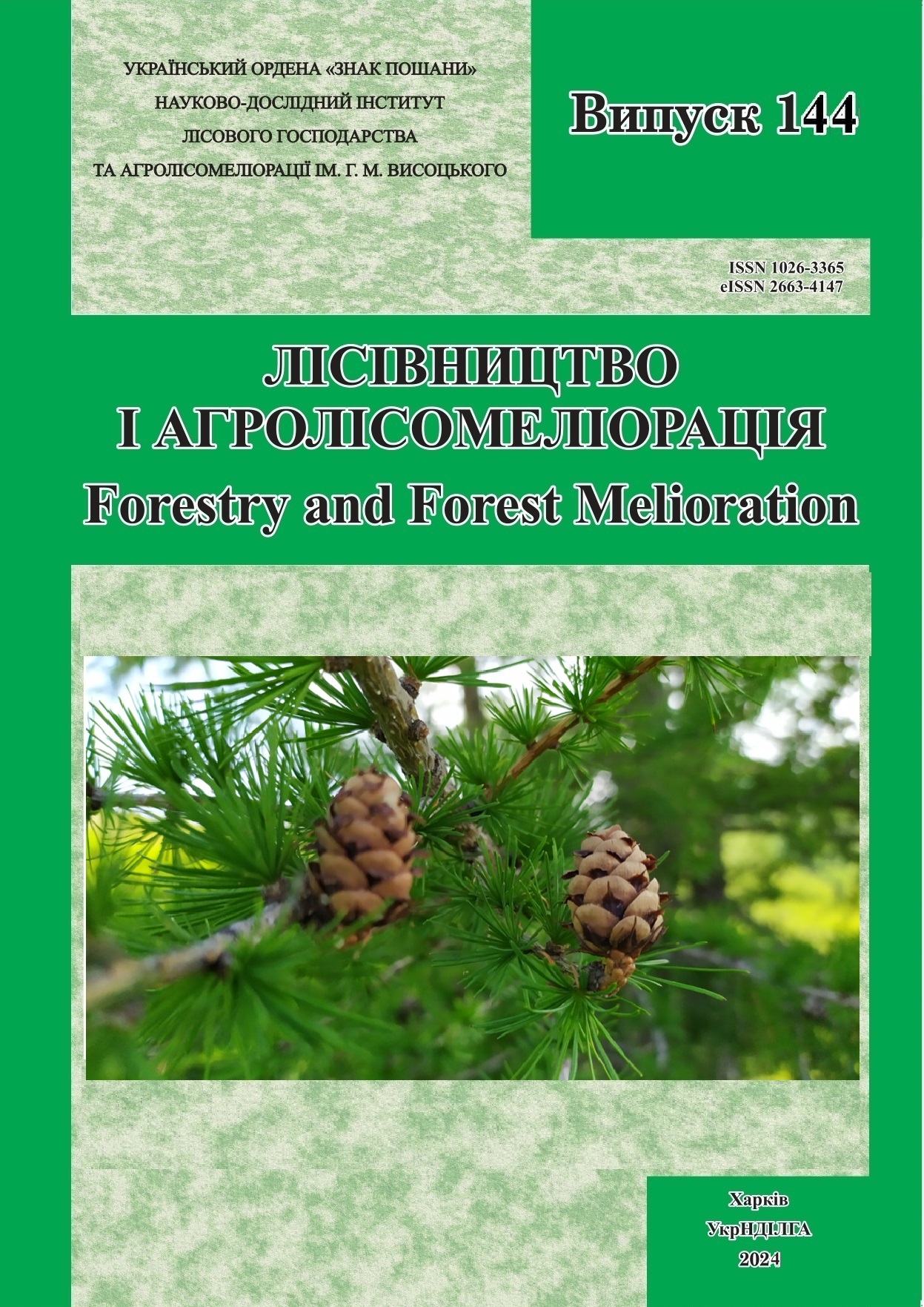Анотація
Виявлено особливості трансформації ланки «опад – підстилка» соснових лісостанів в умовах антропотехногенного забруднення та рекреації. Запас і структура лісової підстилки залежать від типу лісорослинних умов і віку насаджень. Через порушення екологічних умов уповільнюються процеси мінералізації фітодетриту. Унаслідок цього накопичується мортмаса, що відбивається на запасах, потужності та структурі підстилки. Так, у техногенній зоні період формування лісової підстилки збільшується
на 0,9–3,0 року, а вміст важких металів у ній – у 3,4–5,5 разу, ніж за межами цієї зони. У міру збільшення рівня рекреаційного навантаження зменшується запас підстилки, а тривалість існування мортмаси в усіх підгоризонтах подовжується (різниця між сосняками першої та четвертої стадій рекреаційної дигресії становить один рік). Одержані дані свідчить про доцільність використання показників запасу, потужності та структури підстилки для індикації інтенсивності антропотехногенного впливу.
Посилання
Alexandrova, L.N. (1980) Organic matter and processes of its transformation, Leningrad: Nauka (in Russian).
Banerjee, R., Gangopadhyay, S., Batabyal, S., Das, N., Ray, H. and Mandal, S. (2023) ‘Litter dynamics of forest ecosystem in an urban and pristine area of West Bengal, India’, Journal of Environmental Biology, 44, pp. 691–698.
Bogatyrev, L.G. (1996) ‘Formation of litter is one of the most important processes in forest ecosystems’, Soil Science, 4, pp. 501–511. (in Russian).
Bondaruk, G.V. (1986) ‘Effect of recreational pressure on forest litter characteristics’, Forestry and Forest Melioration, 72, pp. 54–56 (in Russian).
Chornobay, Yu.M. (2000) Transformation of plant detritus in natural ecosystems. Lviv: Publishing House of the State Natural Museum of NAS of Ukraine (in Ukrainian).
Davidova, N.D. (1983) Forest litter in the zone of technogenic influence. Moscow: Nauka (in Russian).
Ganteaume, A., Jappiot, M., Lampin-Maillet, C., Curt, Th. and Borgniet, L. (2011) ‘Effects of vegetation type and fire regime on flammability of undisturbed litter in Southeastern France’, Forest Ecology and Management, 261(12), pp. 2223–2231. https://doi.org/10.1016/j.foreco.2010.09.046
Grishina, L.A. (1986) Humus formation and humus status of soils. Moscow: Moscow State University (in Russian).
Jackson, D.R. and Watson, A.P. (1997) ‘Disruption of nutrient pools and transport of heavy metals in a forested watershed near the lead smelter’, Journal of Environmental Science, 6 (4), pp. 331–338.
Karpachevsky, L.O. (1981) Forest and forest soils. Moscow: Lesnaya Promyshlennost (in Russian).
Koptsik, G.N., Koptsik, S.V. and Murashkina-Miis, M.A. (2001) ‘Chemical properties of forest litter under atmospheric pollution’, Forestry, 6, pp. 22–28 (in Russian).
Mikryukov, V.S. and Dulya, O.V. (2017)‘Contamination-induced transformation of bacterial and fungal communities in spruce-fir and birch forest litter’, Applied Soil Ecology, 114, pp. 111–122. https://doi.org/10.1016/j.apsoil.2017.03.003
Pogrebnyak, P.S. (1993) Forest ecology and forest typology. Kyiv: Naukova Dumka (in Ukrainian).
Rodin, L.E and Bazilevich, N.I. (1965) Dynamics of organic matter and biological circulation of ash elements and nitrogen in the main types of vegetation of the globe. Leningrad: Nauka (in Russian).
Sawicka-Kapusta, K, Zakrzewska, M., Bajorek, K. and Gdula-Argasi?ska, J. (2003) ‘Input of heavy metals to the forest floor as a result of Cracow urban pollution’, Environment International, 28(8), 691–698. https://doi.org/10.1016/S0160-4120(02)00069-7
Uchvatov, V.P. (1983) The role of forest litter in transformation of the geochemical flow of substances in the forest ecosystem. Moscow: Nauka (in Russian).
Vodyanitskii, Yu.N., Vorobeichik, E.L. and Savichev, A.T. (2016) ‘Heavy Metals as a Biodegradation Inhibitor of the Forest Litter. Chapter V’, in Alvarez, J. (ed.) Biodegradation: Properties, Analysis and Performance. New-York: NOVA, pp. 201–226.
Vorobeichik, E.L. (2003) ‘Reaction of forest litter and its connection with soil biota during toxic pollution’, Forestry, 2, pp. 32–42 (in Russian).
Voron, V.P. (2021) Aerotechnogenic transformation of forests in Ukraine. Part 1 Atmospheric pollution by acids and nitrogen, leaching phytotoxicants and important metals. Kharkiv: Nove Slovo (in Ukrainian).
Voron, V.P., Ivashinyuta S.V., Koval I.M. and Bondaruk M.A. (2008) Forests of the green zone of Rivne and their ecological protection functions. Kharkiv (in Ukrainian).

Ця робота ліцензується відповідно до Creative Commons Attribution 4.0 International License.

